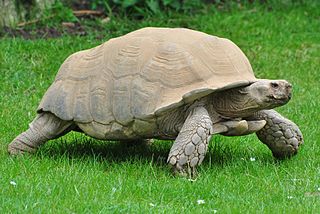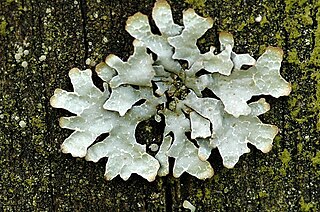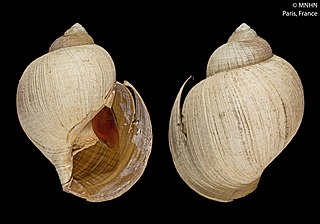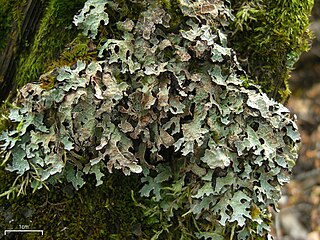
The African spurred tortoise, also called the sulcata tortoise, is an endangered species of tortoise inhabiting the southern edge of the Sahara Desert, the Sahel, in Africa. It is the largest mainland species of tortoise in Africa, and the third-largest in the world, after the Galapagos tortoise and Aldabra giant tortoise. It is the only living species in its genus, Centrochelys.

Parmelia is a genus of medium to large foliose (leafy) lichens. It has a global distribution, extending from the Arctic to the Antarctic continent but concentrated in temperate regions. There are about 40 species in Parmelia. In recent decades, the once large genus Parmelia has been divided into a number of smaller genera according to thallus morphology and phylogenetic relatedness.

Callitris sulcata is a species of conifer in the cypress family, Cupressaceae. Its common name is Sapin de Comboui. It is endemic to New Caledonia, where it grows only in three forested river valleys. It is an endangered species with a global population of no more than 2500 individuals.
Newcombia sulcata is a species of tropical tree-living air-breathing land snail, arboreal pulmonate gastropod mollusk in the family Achatinellidae. This species is endemic to the United States.
Ilex sulcata is a species of plant in the family Aquifoliaceae. It is endemic to Venezuela. Some authorities have it as a synonym of Ilex chimantaensis.

Anemonia sulcata, or Mediterranean snakelocks sea anemone, is a species of sea anemone in the family Actiniidae from the Mediterranean Sea. Whether A. sulcata should be recognized as a synonym of A. viridis remains a matter of dispute.

Parmelia sulcata, commonly known as the hammered shield lichen or cracked-shield lichen, is a foliose lichen in the family Parmeliaceae. First described by Thomas Taylor in 1836, it is one of the most prevalent lichen species globally, known for its resilience to pollution and cosmopolitan distribution across temperate and cold regions of both hemispheres. P. sulcata forms a circular thallus up to 10 cm (4 in) in diameter, with a glaucous white to grey upper surface and a black lower surface, featuring broadly lobed structures with both marginal and laminal soralia and a distinctive reticulate pattern of pseudocyphellae.

Terebralia is a genus of sea snails, marine gastropod mollusks in the family Potamididae.

Oocorys is a genus of large, deepwater sea snails, marine gastropod mollusk in the family Cassidae, the helmet snails and bonnet snails.

Clavulinopsis sulcata is a clavarioid fungus in the family Clavariaceae and is the type species of the genus Clavulinopsis. It forms very long, slender, cylindrical pinkish or orange fruiting bodies that grow on the ground among plant litter. A vernacular name that has been used for the species is flame fungus.

Centrochelys atlantica is a putative extinct species of tortoise supposed to have lived in the Pleistocene recorded in the volcanic crater on Sal, Cape Verde. Tortoise fossils were described but not named from the crater in 1935. Four further bones from a private collector supposed to have been found in the same crater were described in 1998 as a new species similar to the extant Testudo calcarata, differentiated from C. sulcata by its smaller size and lesser robusticity.

Centrochelys is a genus of tortoise. It contains one living species, the African spurred tortoise, native to the Sahel and adjacent areas. A number of fossil species have been attributed to this genus, but their placement in the genus is considered equivocal.
Ilnacorella sulcata is a species of plant bug in the family Miridae. It is found in North America.
Falagria sulcata is a species of rove beetle in the family Staphylinidae. It is found in North America and Europe.
Bitoma sulcata is a species of cylindrical bark beetle in the family Zopheridae. It is found in Central America and North America.
Lachesilla sulcata is a species of fateful barklouse in the family Lachesillidae. It is found in Central America and North America.

Antheminia is a genus of true bugs belonging to the family Pentatomidae.

Peltogasterella is a genus of parasitic barnacles in the family Peltogasterellidae. There are at least four described species in Peltogasterella.

Peltogasterellidae is a small family of parasitic barnacles in the class Thecostraca. There 4 genera and about 10 described species in Peltogasterellidae.

Parmelia barrenoae is a species of foliose lichen in the large family Parmeliaceae. It was formally described as a new species in 2005. Before this, it was lumped together as one of several lichens in the Parmelia sulcata group—a species complex of genetically distinct lookalikes. Parmelia barrenoae is widely distributed, occurring in Europe, western North America, Africa, and Asia.













